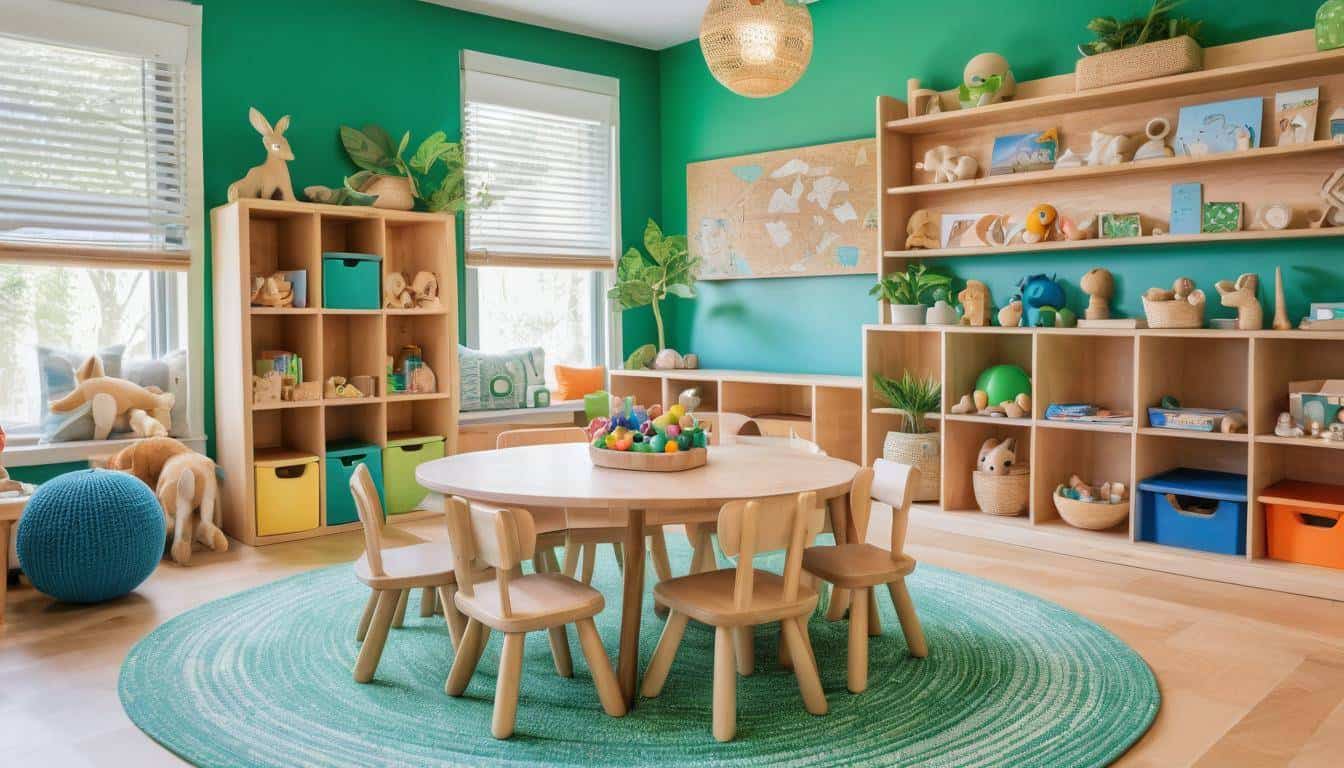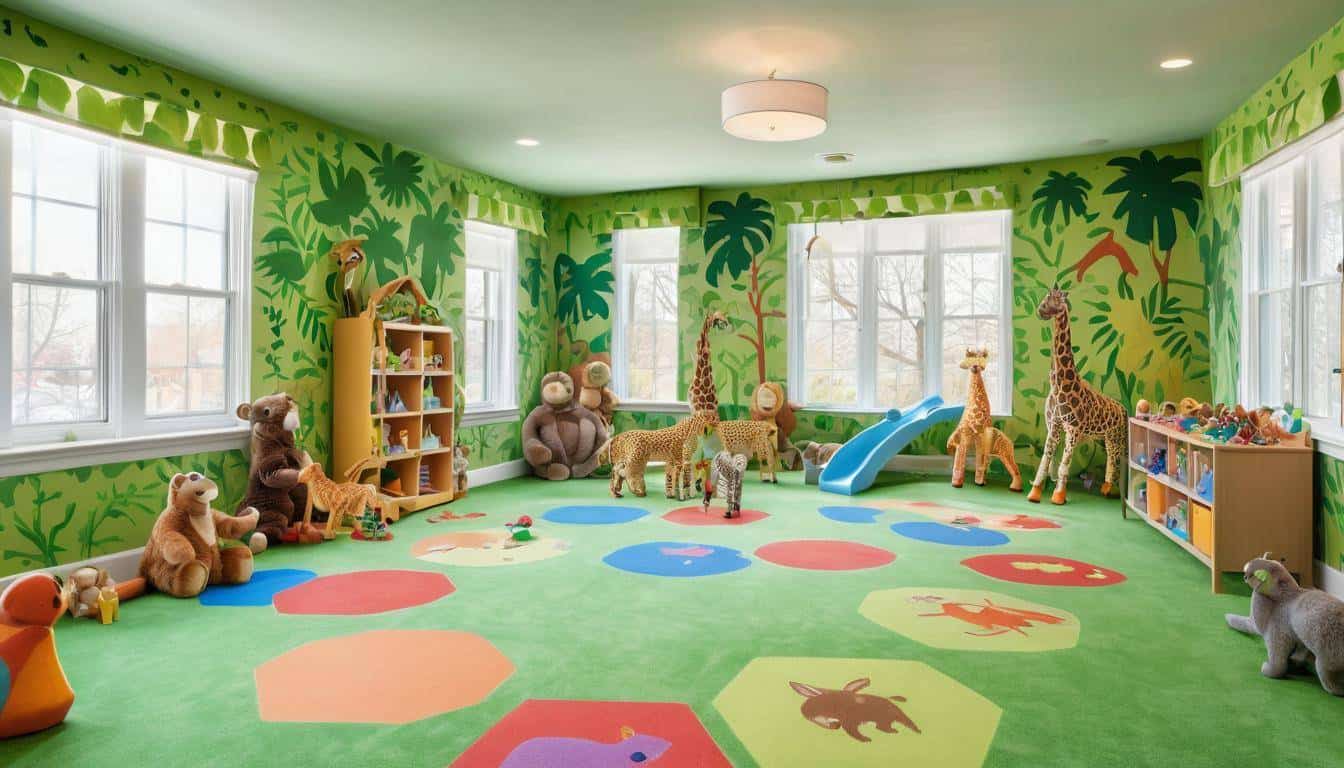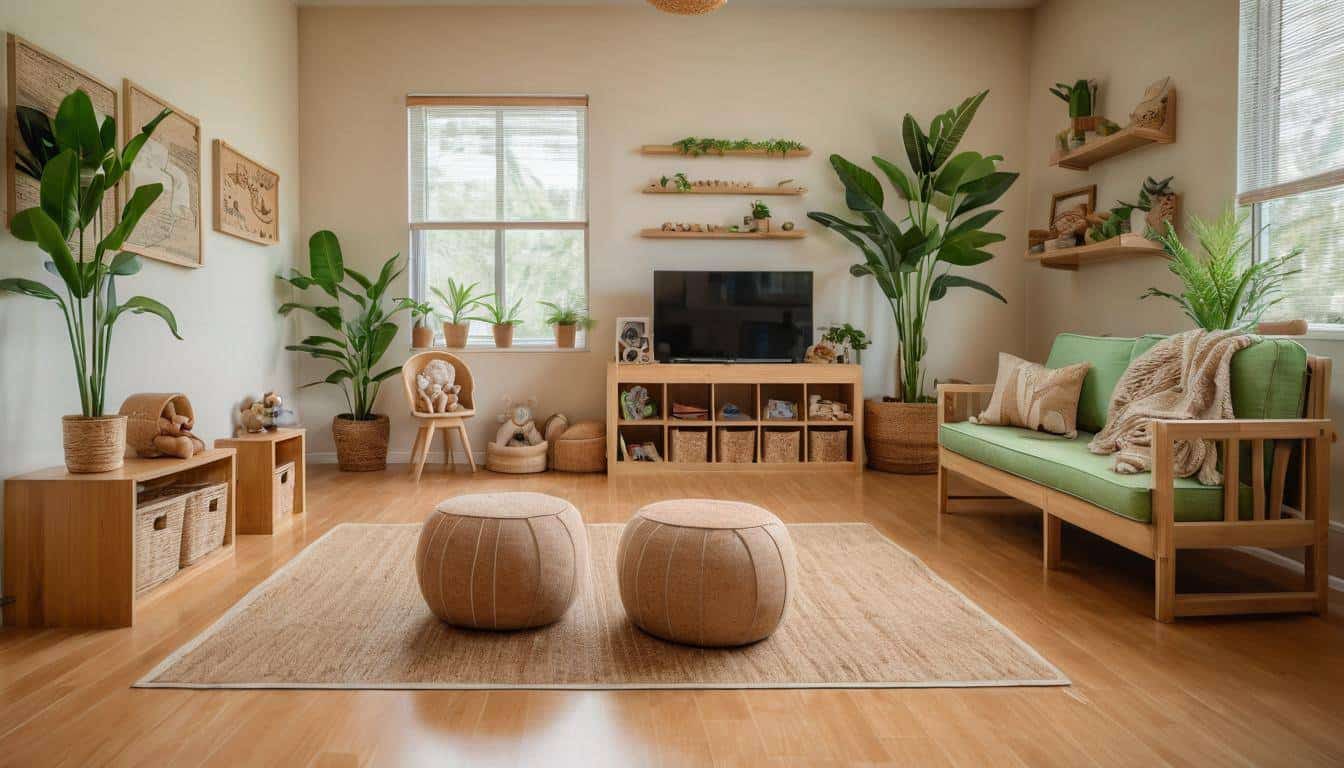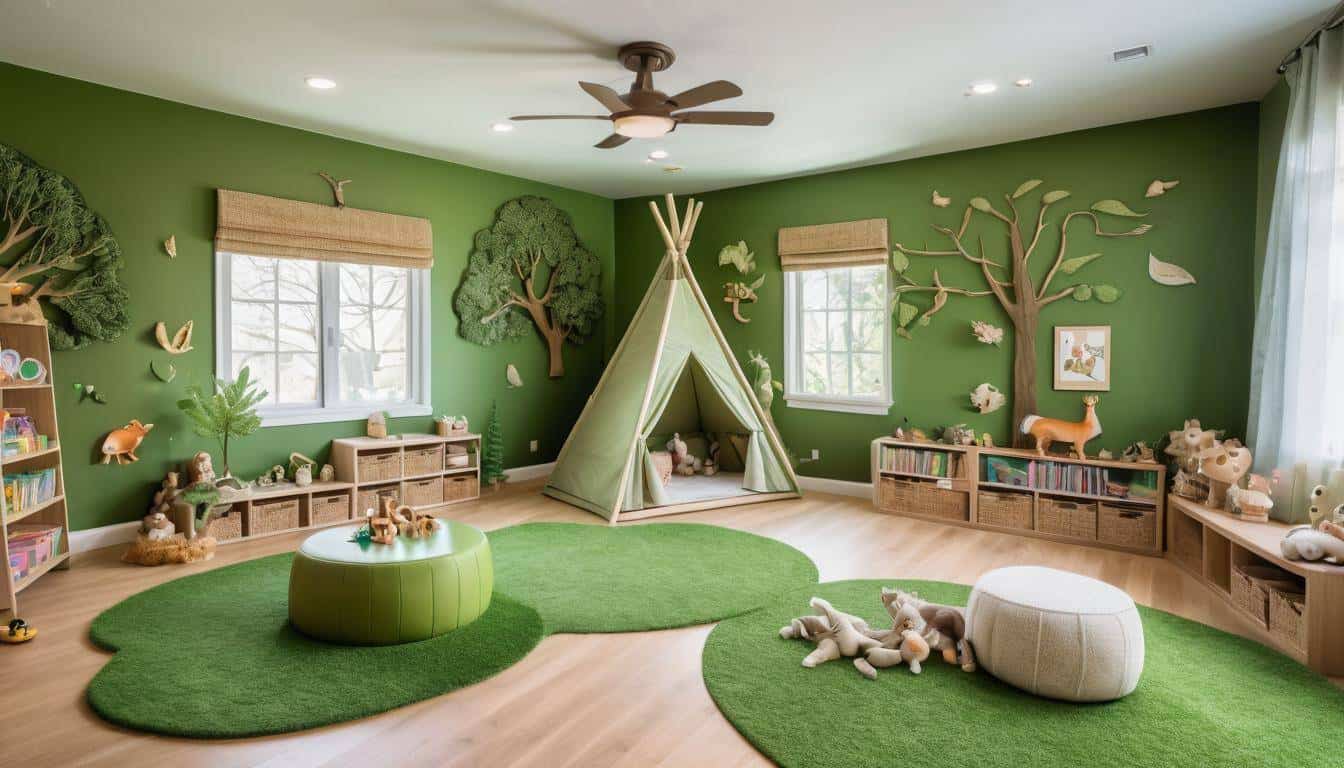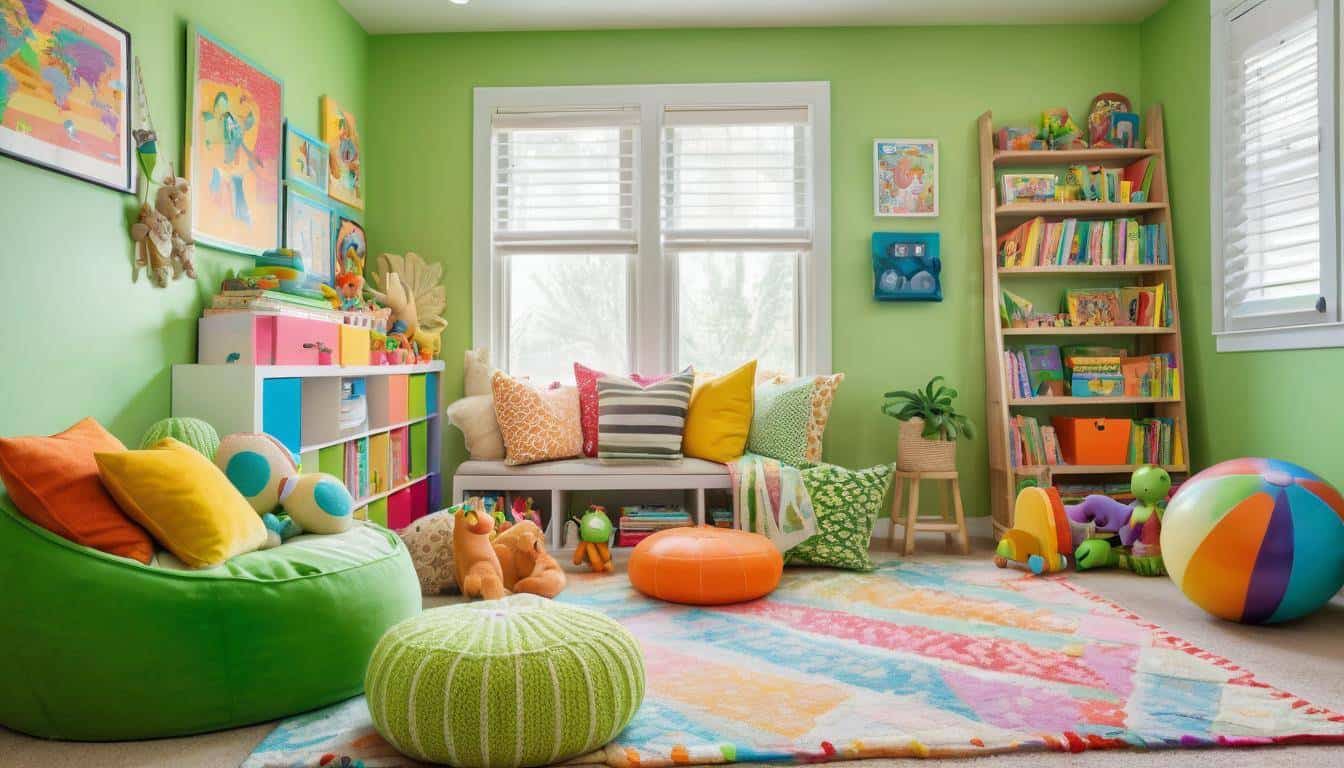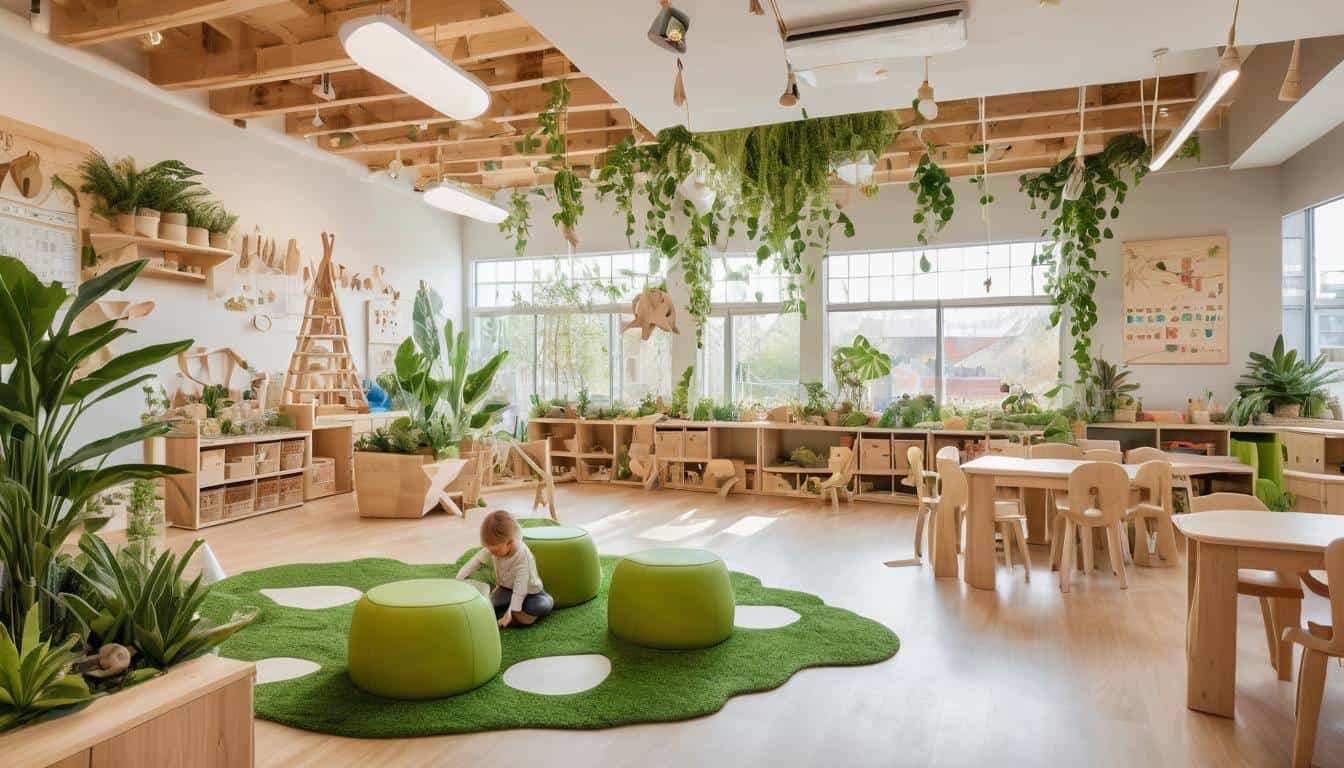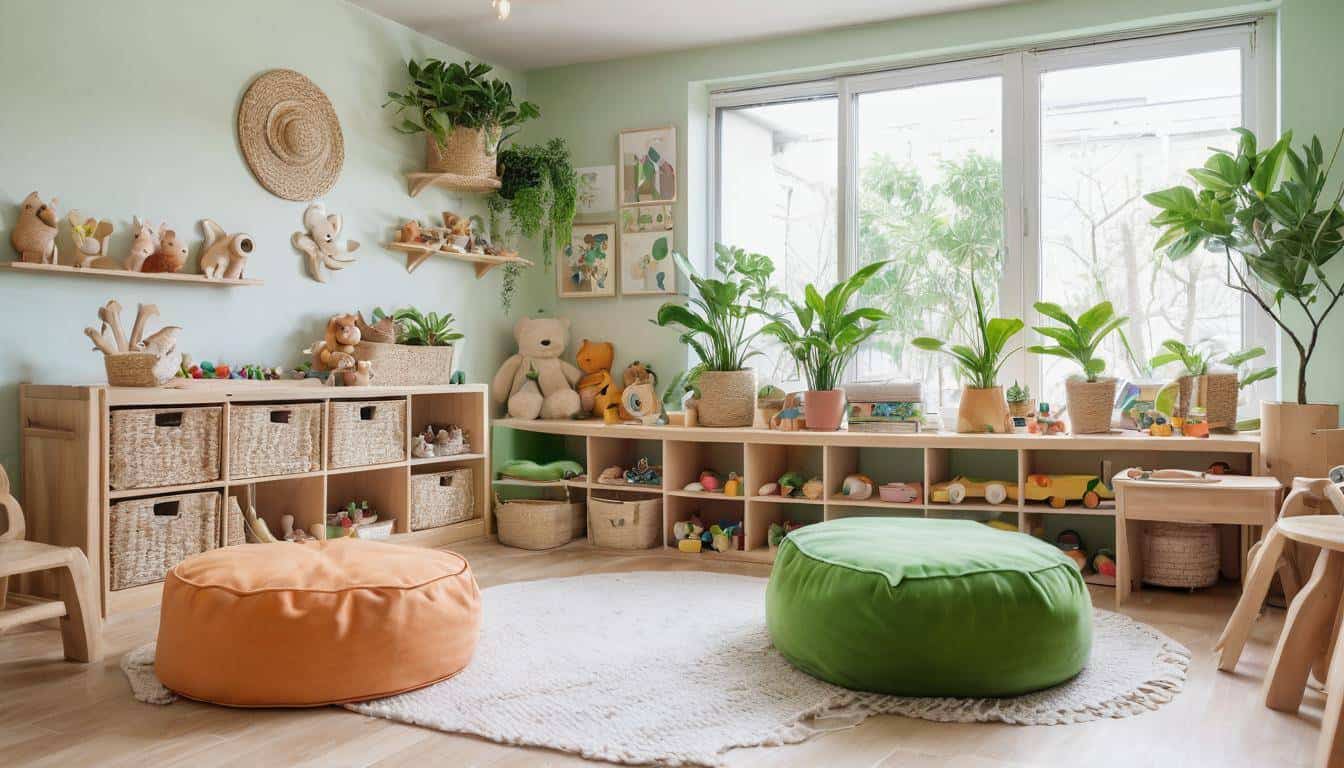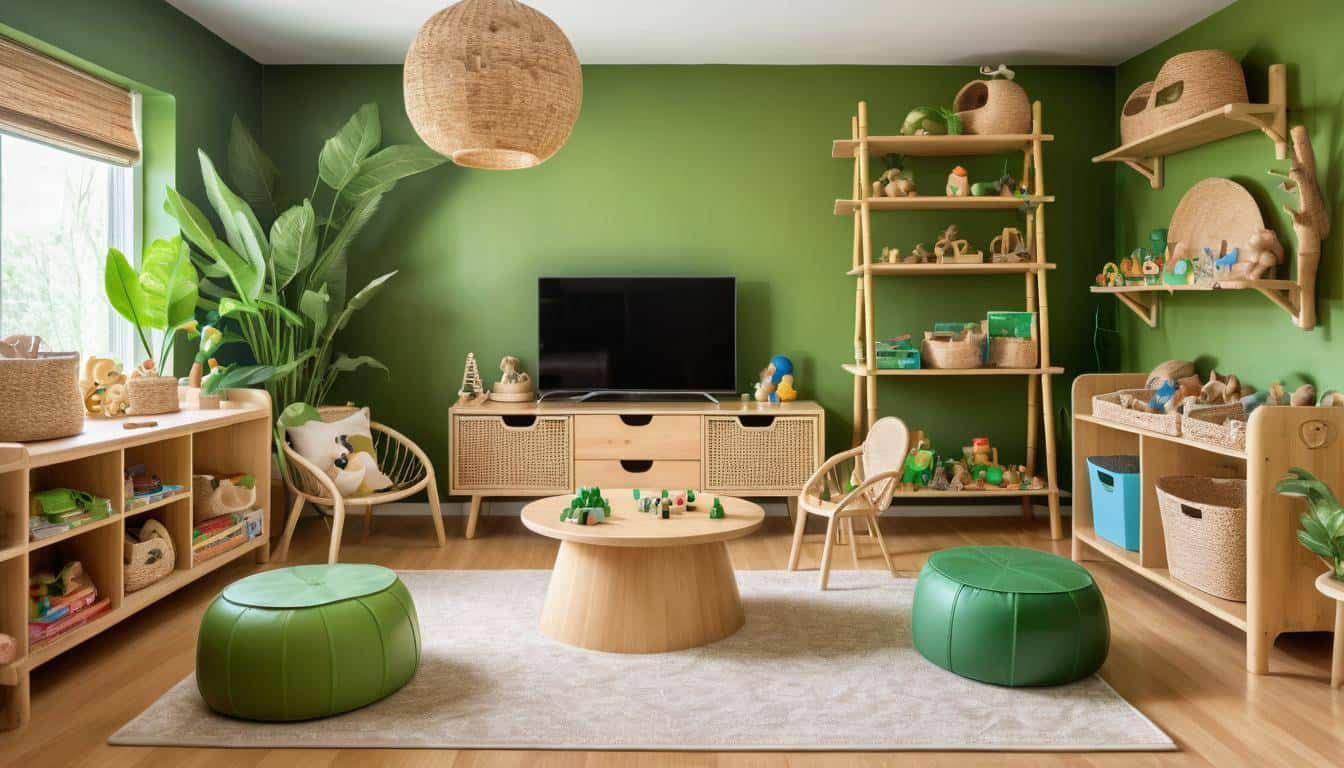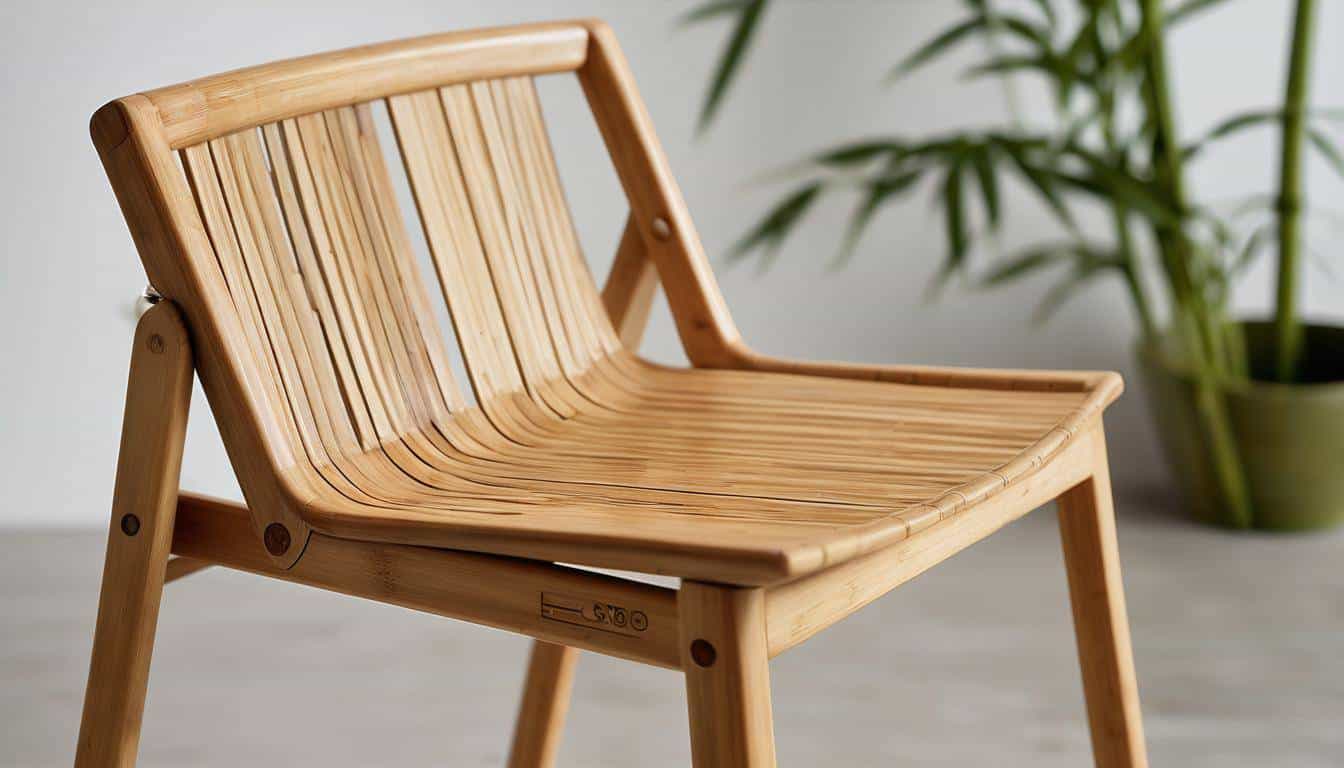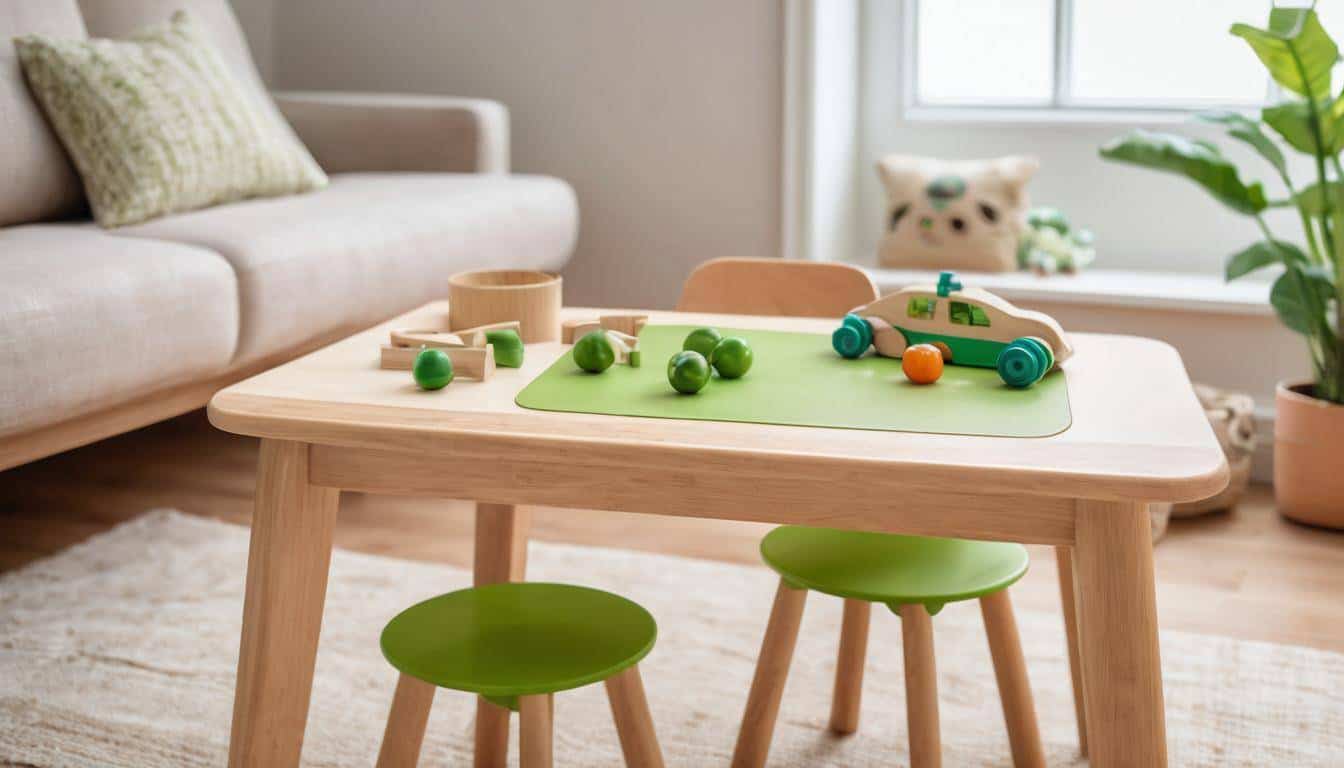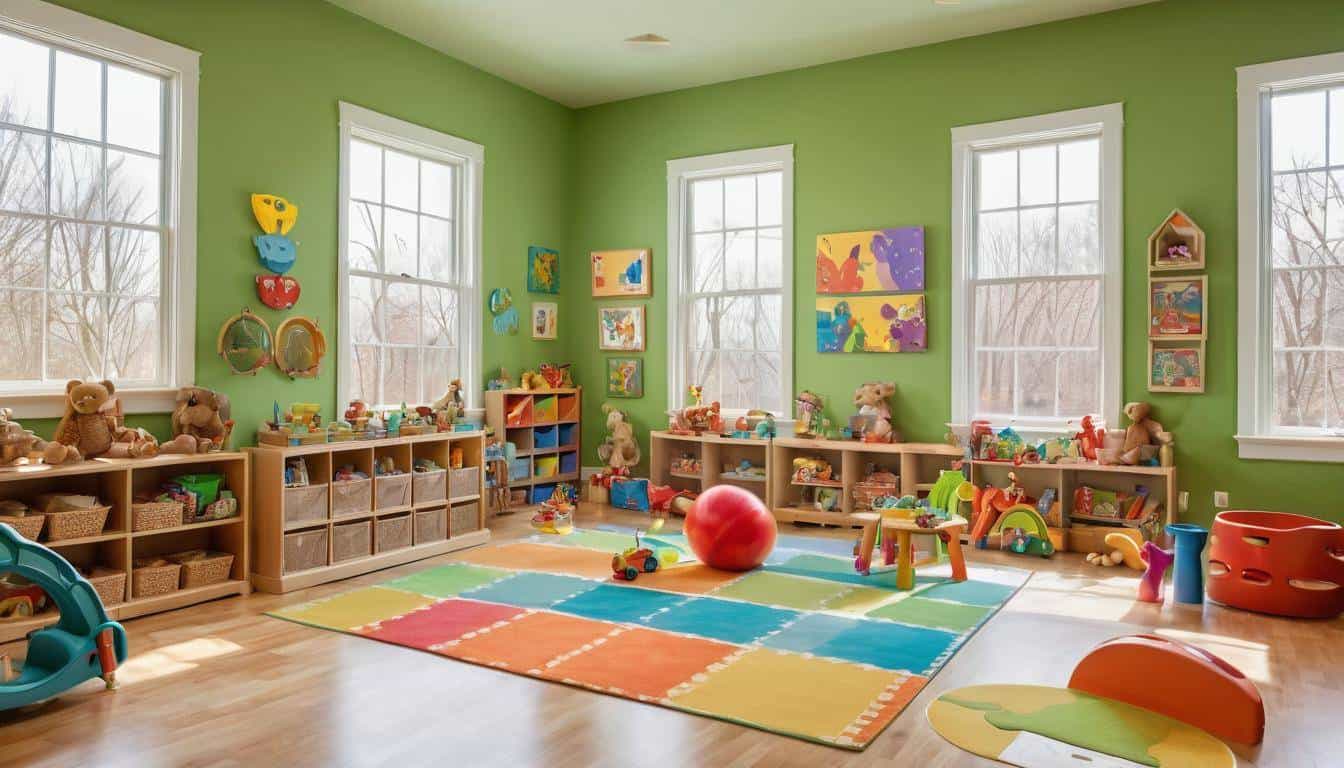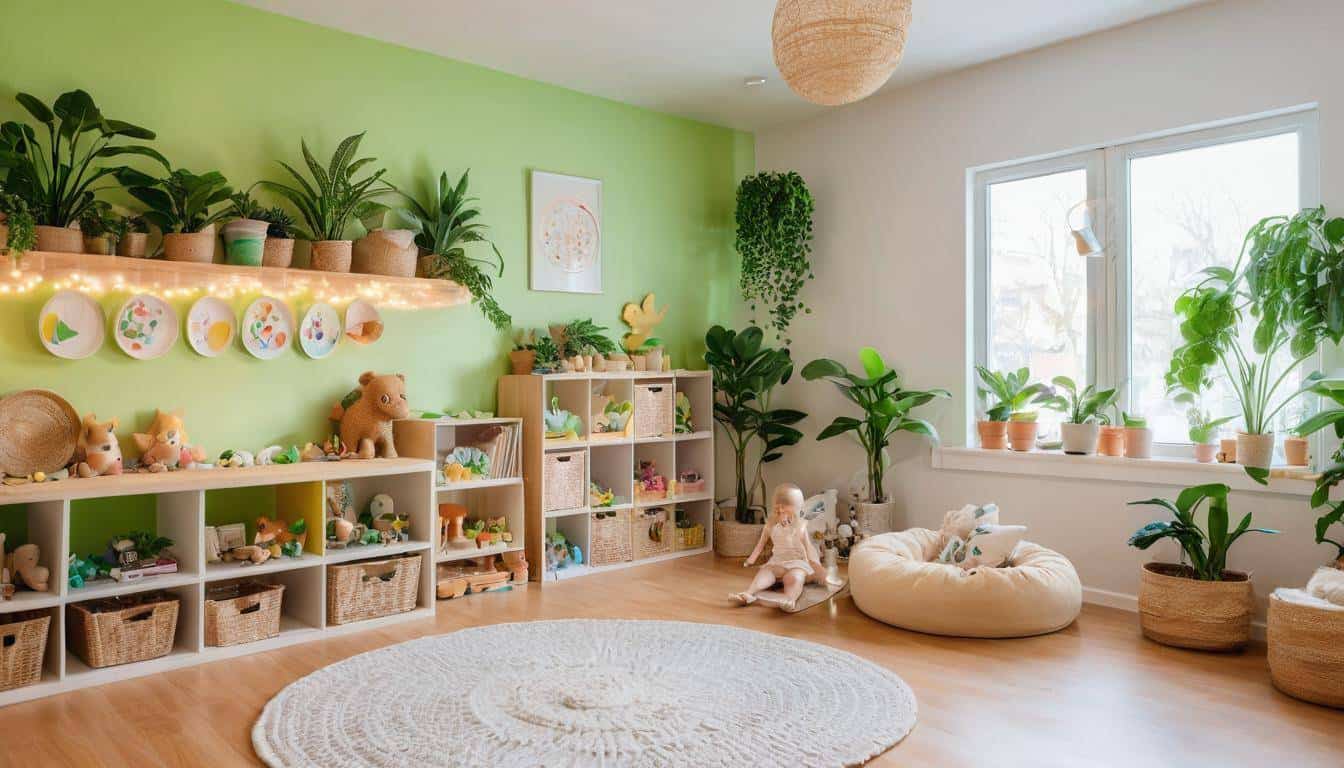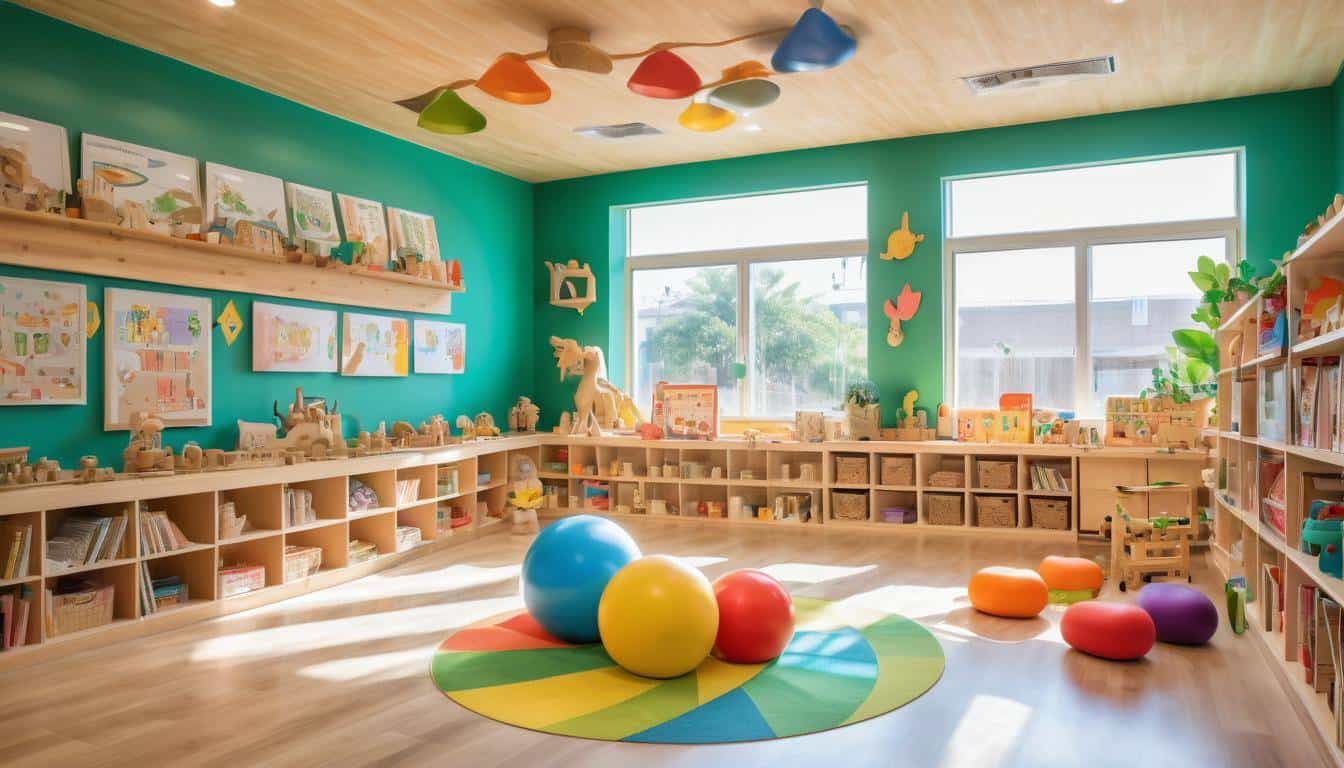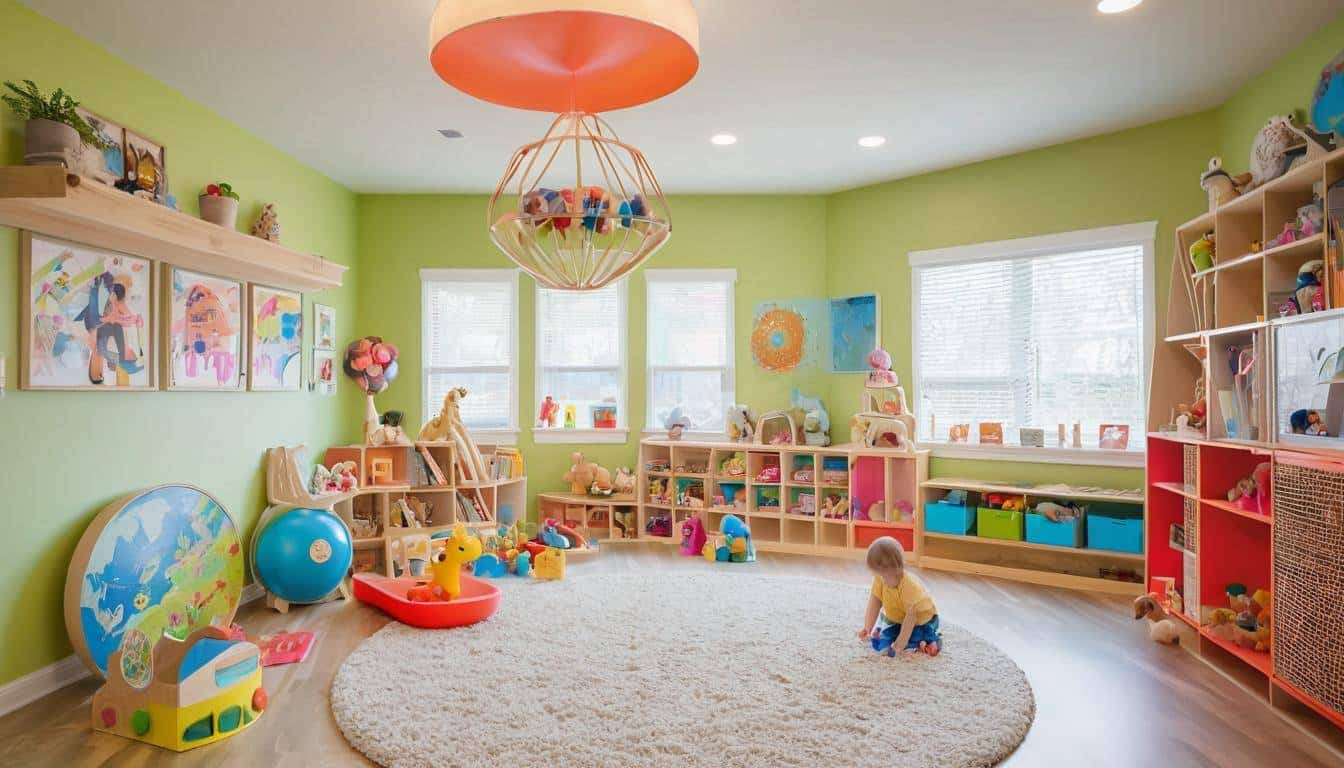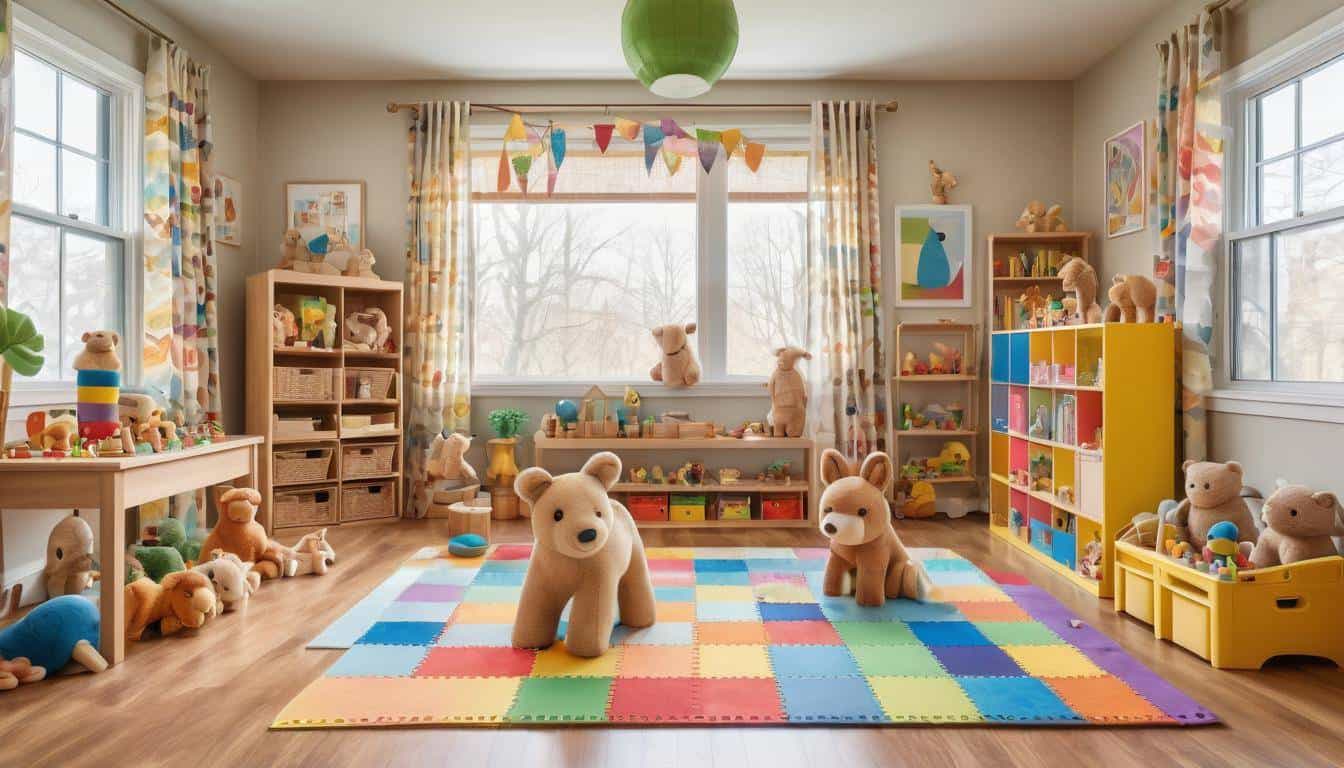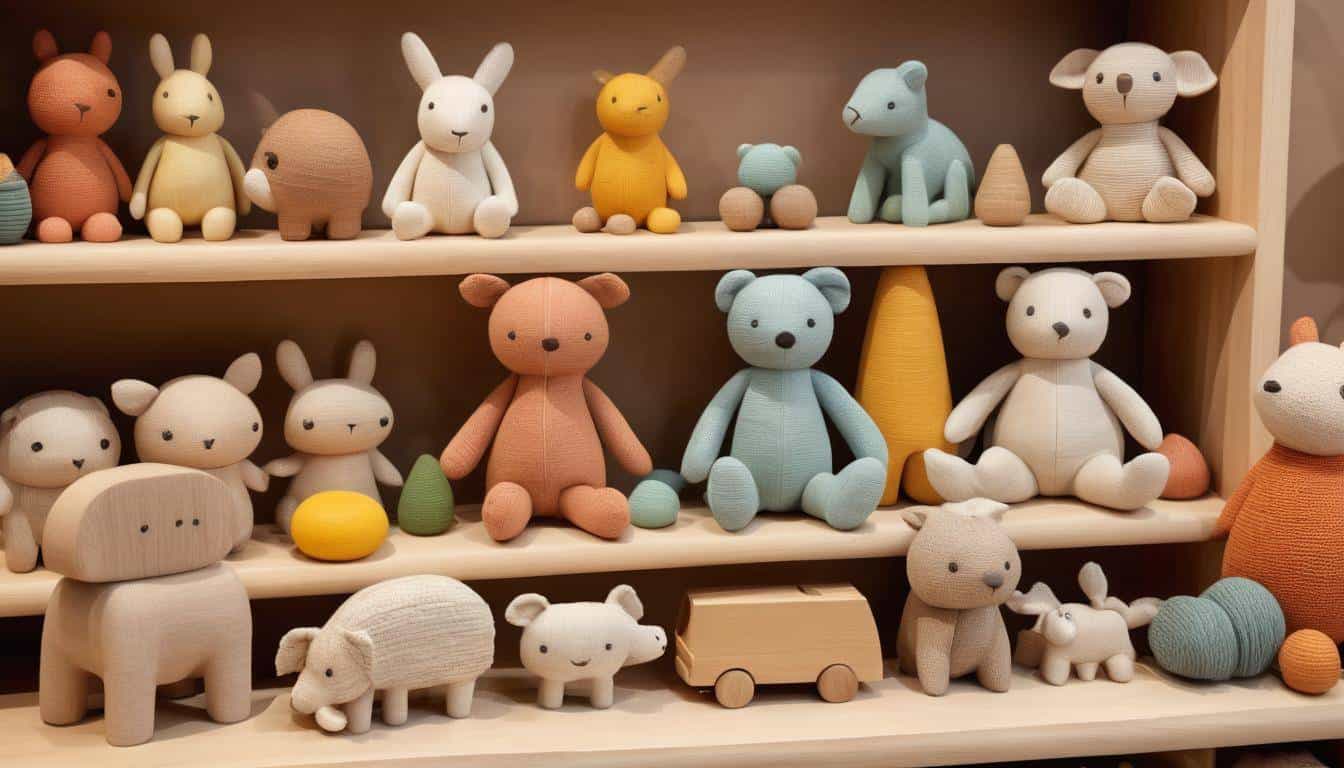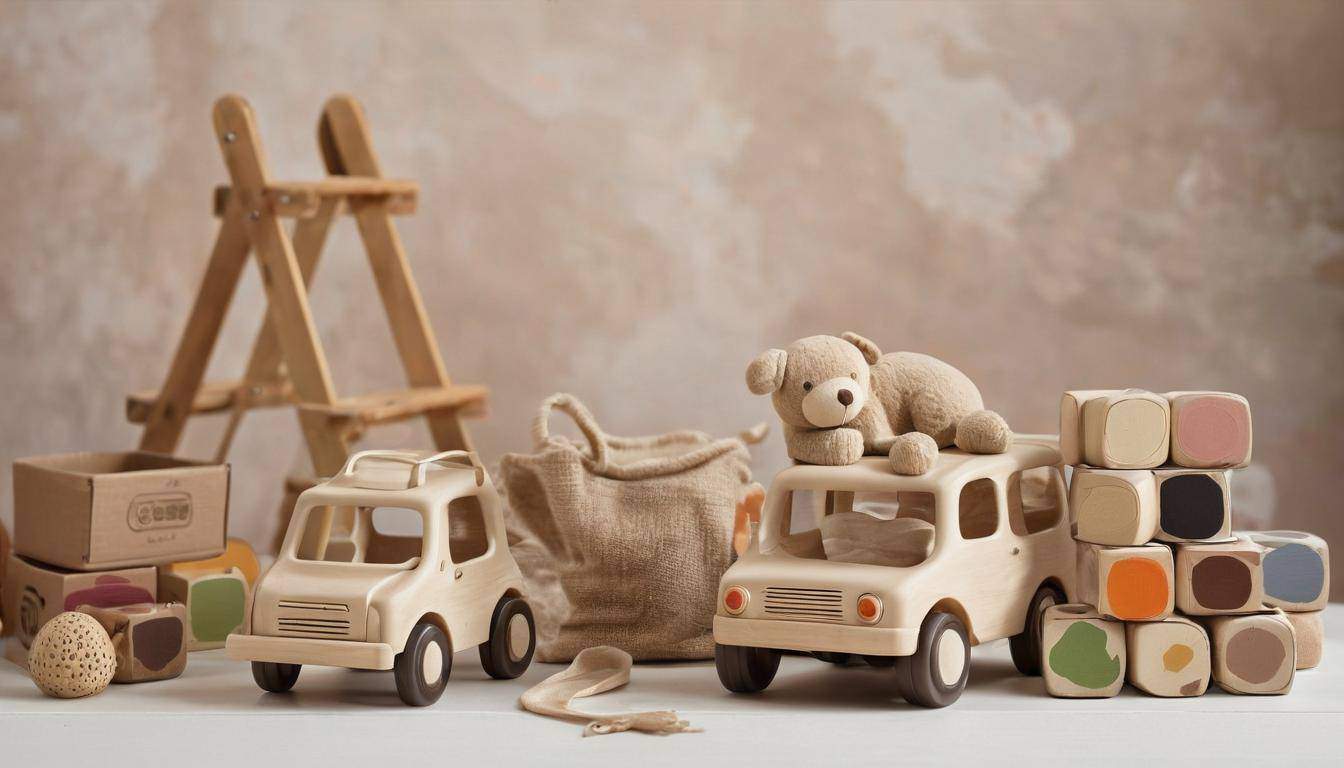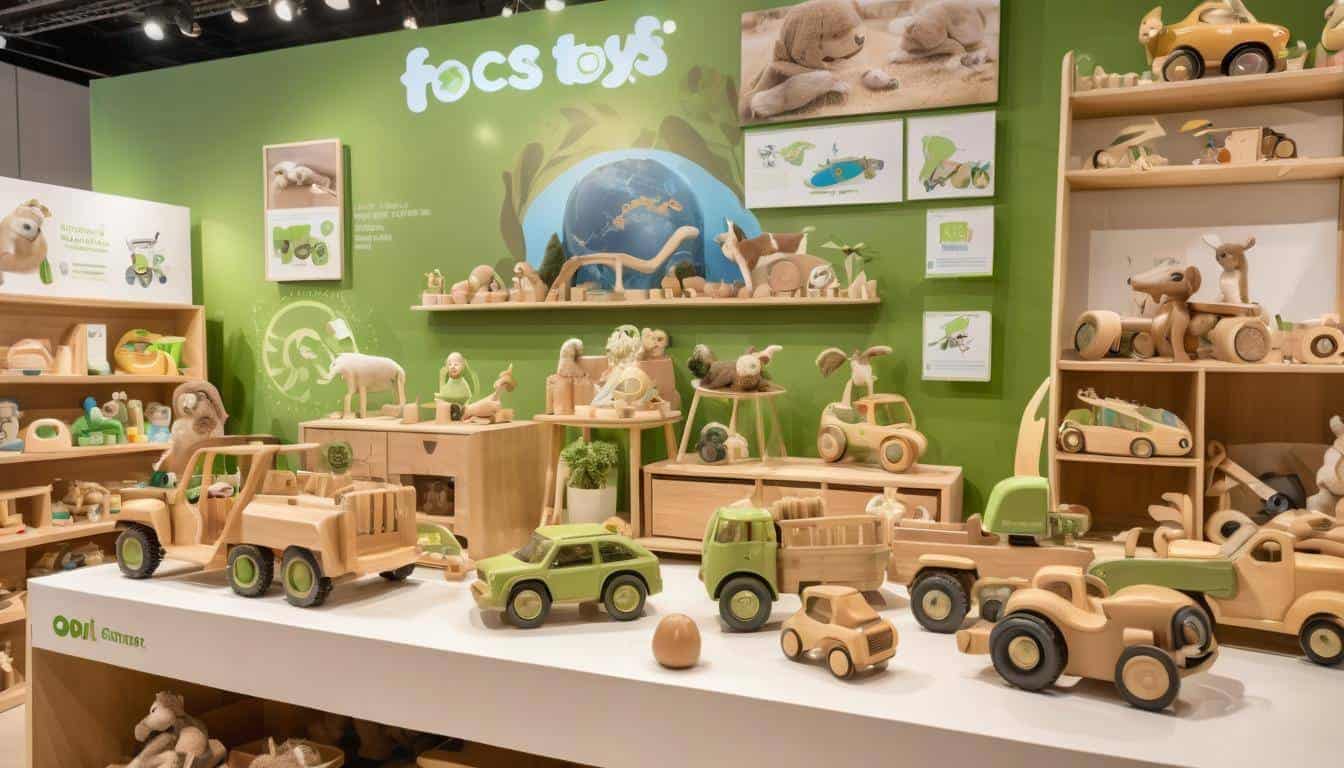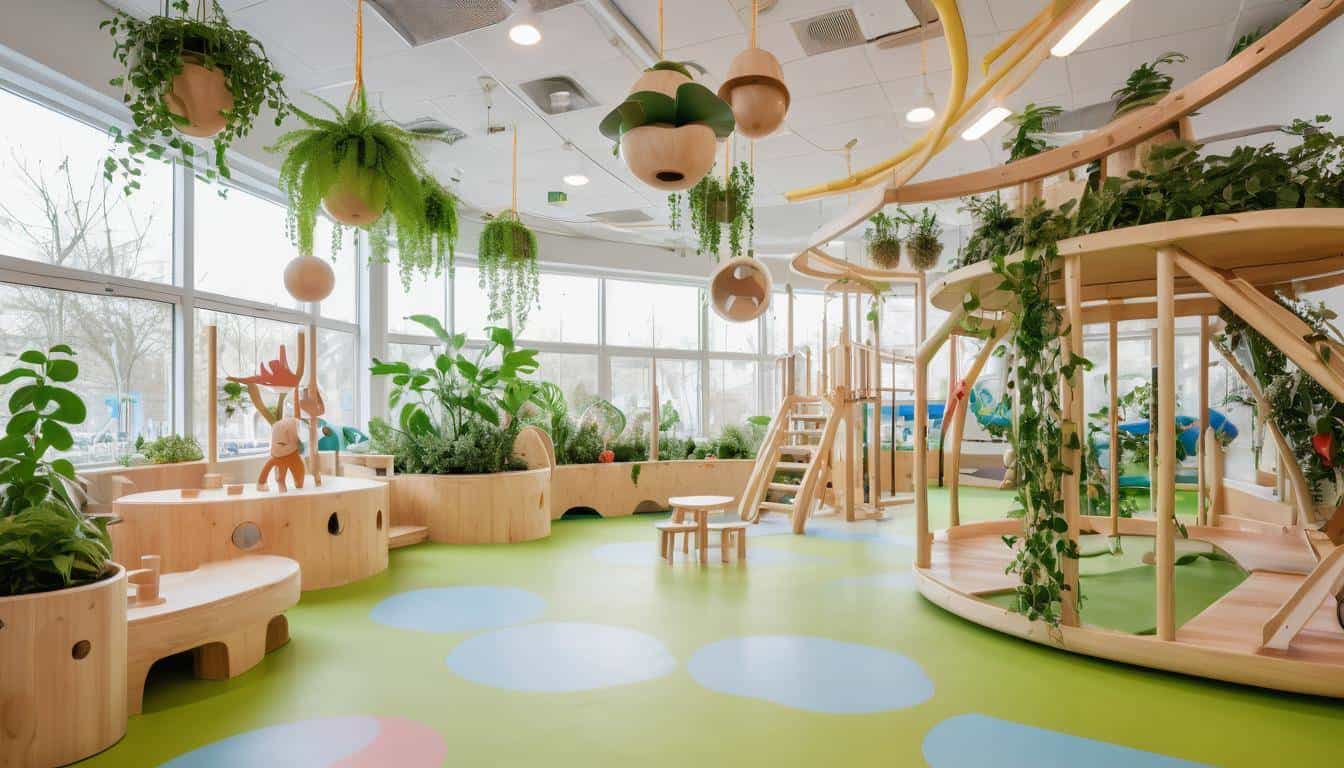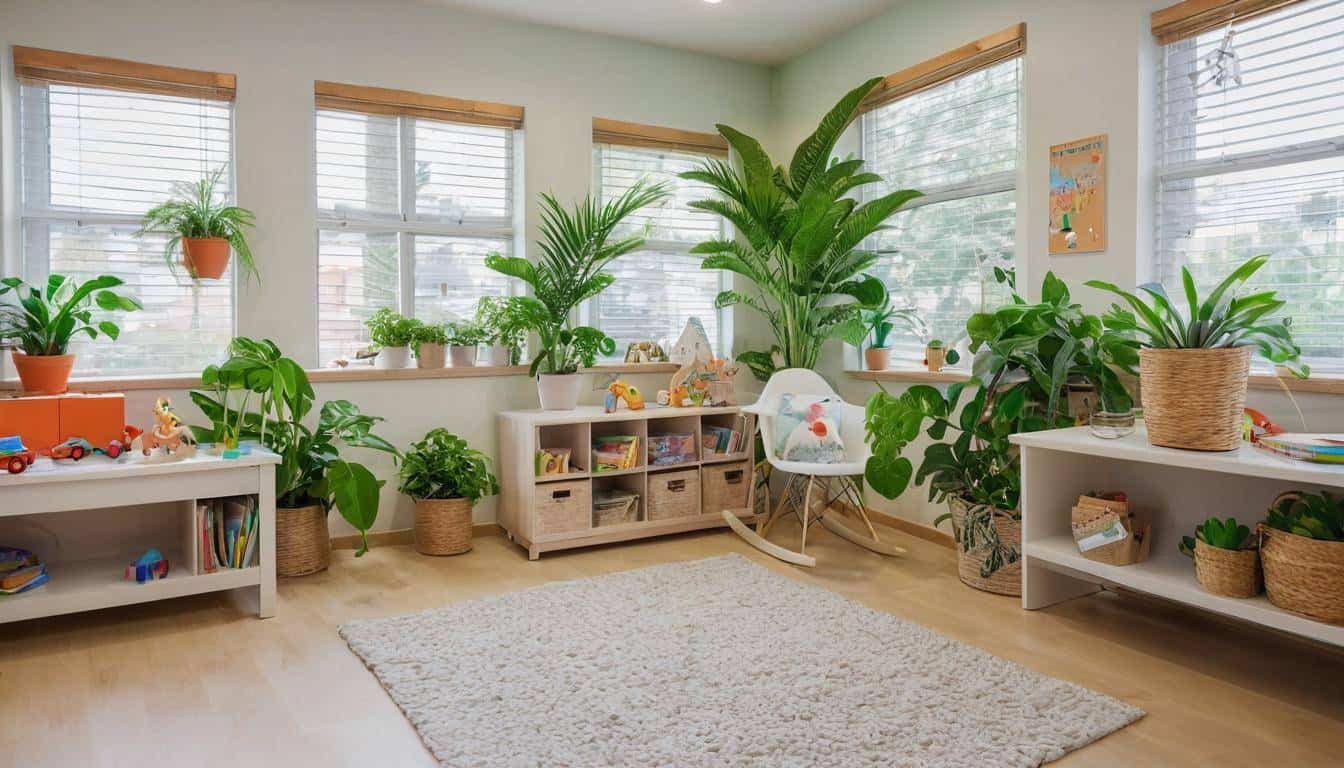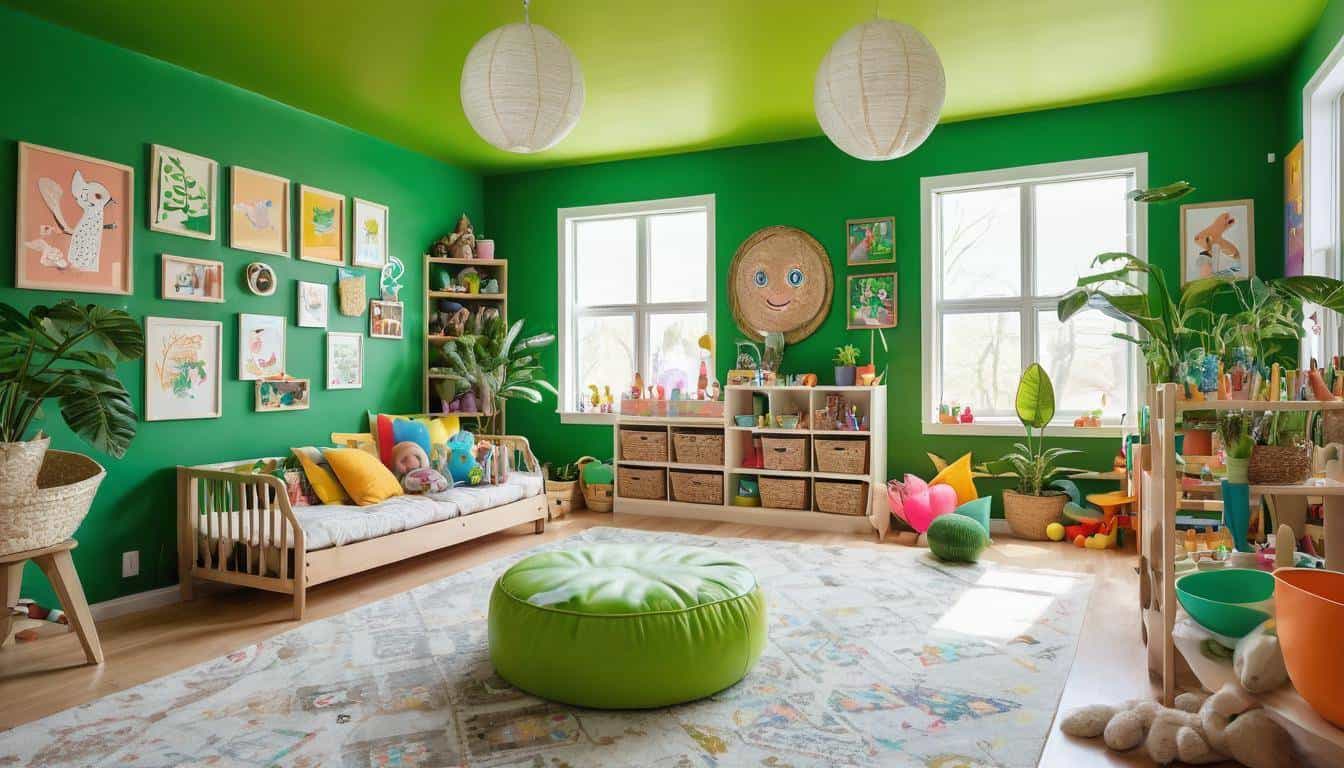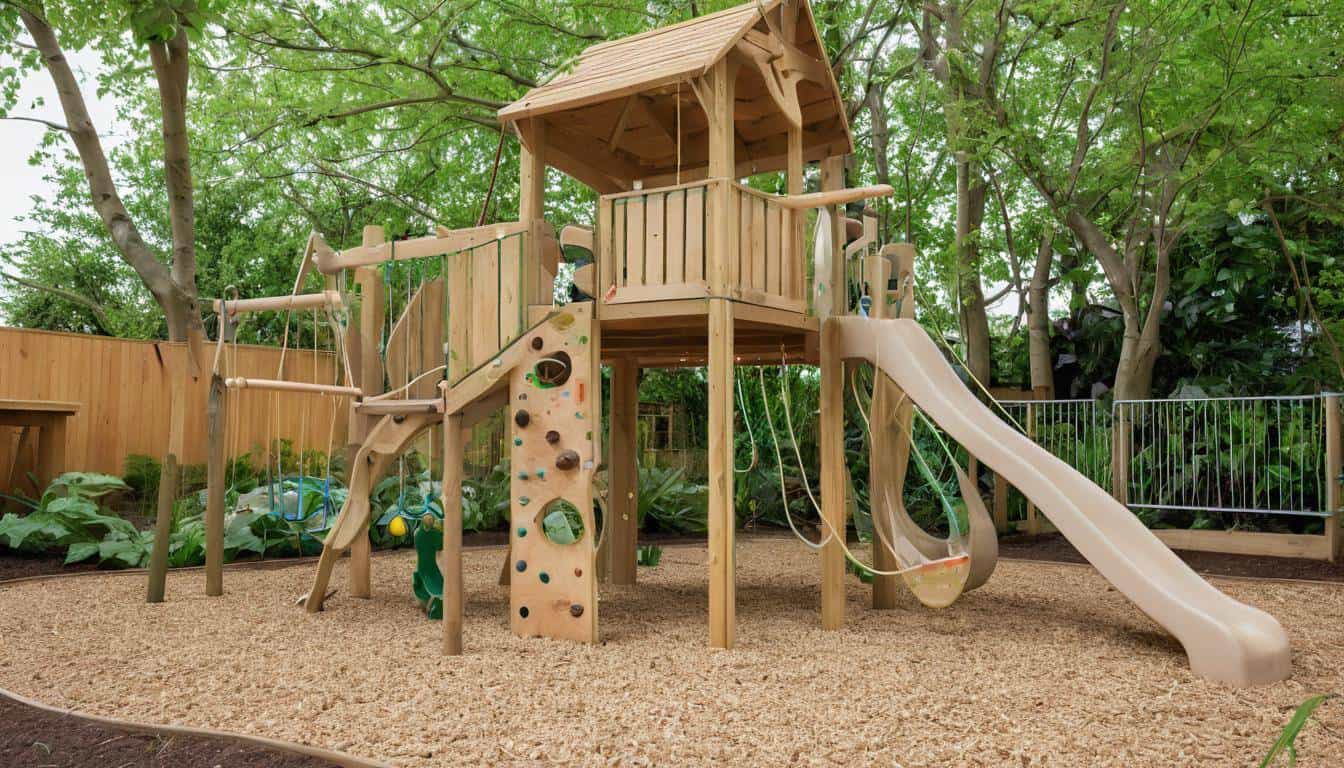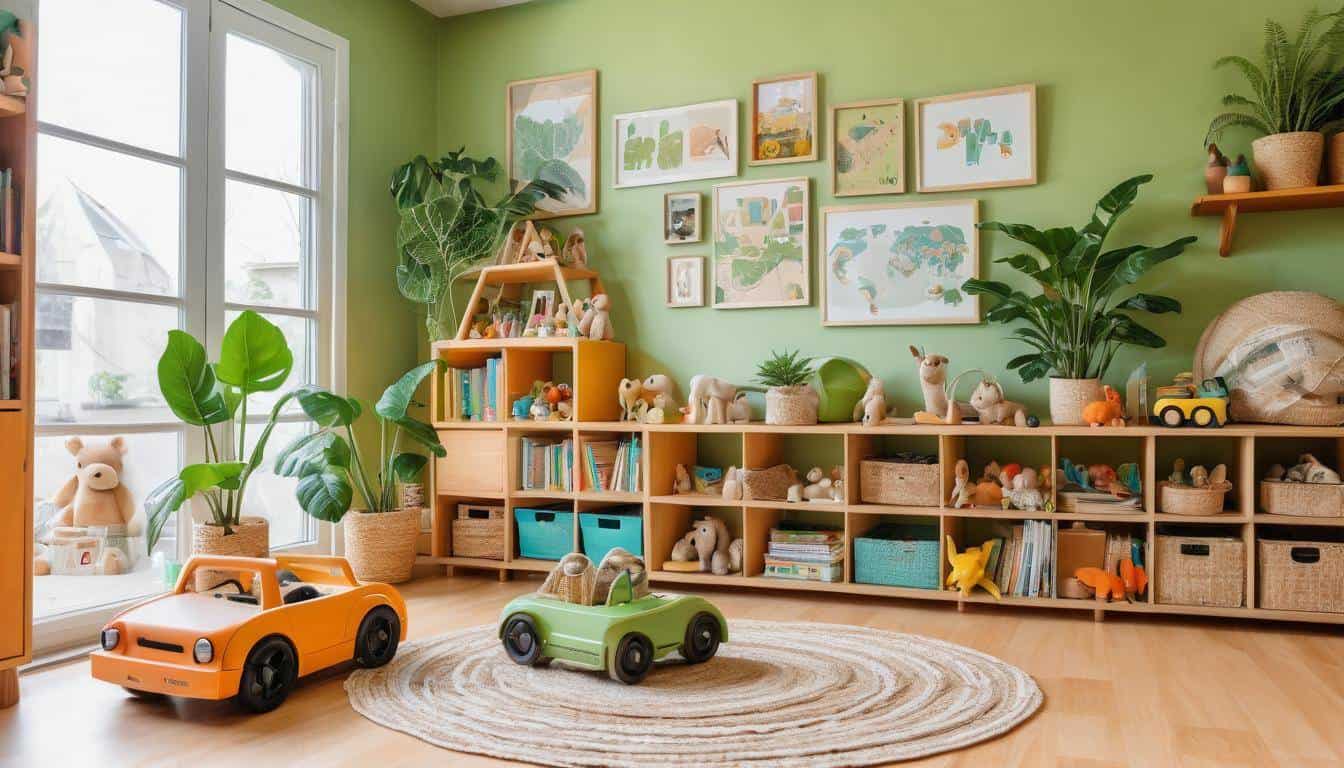Creating an eco-friendly playroom is about making mindful choices. From using furnishings crafted from bamboo, reclaimed wood, or recycled plastic, to laying down cork flooring, every decision makes a difference. But it isn’t just about the physical elements. A color palette inspired by the greens of nature or wallpapers adorned with leaf patterns can stimulate curiosity and encourage a deeper connection with the natural world. Opting for such environment-conscious details not only creates a vibrant space for kids but also teaches them the importance of sustainability from a young age. To ensure top-notch quality and low chemical emissions, look for pieces certified by credible bodies like FSC or GREENGUARD.
Now, let’s get into the detail of setting up these green playrooms.
Designing a green playroom for kids involves incorporating vibrant green wall colors, striped accessories, and furniture in shades of green to create an energizing and imaginative environment. Consider adding elements of biophilic design to foster a connection with nature, and utilize platforms like Amazing Home Decor Co. as a helpful resource for finding inspiration and ideas for creating green playrooms.
Green Playroom Design Ideas
Designing a green playroom encompasses more than just adding a splash of green paint to the walls. It’s about creating an environment that reflects nature, sustainability, and creativity. Let’s explore a few exciting ideas to infuse your playroom with eco-friendly elements that ignite imagination and promote healthy growth.
Natural Materials: Utilize sustainable materials, such as wooden furniture, bamboo accessories, and cork flooring, to cultivate an earthy ambiance. These materials not only exude warmth and comfort but also exemplify eco-consciousness. Consider using furniture made from reclaimed wood or FSC-certified (Forest Stewardship Council) products, which ensure responsible and sustainable forestry practices.
Biophilic Design Elements: Incorporate design elements that evoke the essence of nature, like leaf-patterned wallpaper, botanical-themed rugs, and eco-friendly wall art depicting landscapes or wildlife. These elements foster a sense of connection with the natural world and can stimulate children’s curiosity and appreciation for the environment.
Green Color Palette: Infuse the playroom with varying shades of green to emulate the lush outdoors. From soft pastels to deep emeralds, green creates a calming and rejuvenating atmosphere while stimulating creativity. Opt for non-toxic, low-VOC (Volatile Organic Compounds) paint options to ensure healthier indoor air quality for children. If green isn’t your preferred choice, you might also consider other soothing colors like blue, yellow, pink, or purple for your playroom design.
For example, you might consider accentuating the room with vibrant green throw pillows, area rugs, or window treatments, allowing these pops of color to enliven the space without overwhelming it.
With these design ideas at your disposal, you can craft an engaging and aesthetically pleasing space that nurtures children’s holistic development while instilling values of sustainability and environmental stewardship from an early age.
Embracing an environmentally conscious approach involves not only the design but also the selection of furnishings for your green playroom. Let’s now shift our focus towards evaluating eco-friendly options for furnishing this captivating space.
Selecting Eco-Friendly Furnishings
When it comes to creating an eco-friendly playroom, the choice of furnishings is crucial. The materials used in the production of these items can greatly impact the environmental footprint and the health of your child. It’s not just about avoiding harmful chemicals but also supporting sustainable practices. Here are some useful tips for selecting the right eco-friendly furnishings for your green playroom.
1. Sustainable Materials Look for furnishings made from sustainable materials like bamboo, reclaimed wood, or recycled plastic. These materials have a lower impact on the environment than conventional ones. Bamboo, for example, is a fast-growing and renewable resource that makes it an excellent choice for eco-friendly furniture.
2. Certifications Check for certifications such as FSC (Forest Stewardship Council) or GREENGUARD. FSC certification ensures that the wood used in the products comes from responsibly managed forests that provide environmental, social, and economic benefits. Meanwhile, GREENGUARD certification indicates that the products have low chemical emissions, which helps ensure healthier indoor air quality.
For instance, if you’re considering a wooden play table or bookshelf, look for those made from FSC-certified wood. This assures you that the material has been sourced sustainably without contributing to deforestation or other harmful practices.
By choosing furnishings with these certifications, you are not only promoting sustainable manufacturing practices but also ensuring that your child interacts with eco-friendly products that promote a healthy indoor environment.
Ensuring that the materials used in your furnishings are environmentally friendly is just as important as creating a playful and aesthetically pleasing space in your home. As we continue our exploration of creating a green playroom, let’s move on to how you can incorporate nature-inspired decor while maintaining sustainability.
Choosing Non-Toxic Paints and Lighting
When it comes to a child’s playroom, safety is always a top priority. One way to ensure a safe, healthy space for your children is by carefully choosing the paints used in the room. Opting for non-toxic paints that are free from volatile organic compounds (VOCs) can significantly reduce indoor air pollution. VOCs are chemicals commonly found in many conventional paints that can off-gas and compromise indoor air quality. By choosing non-toxic, VOC-free paints, you’re not only creating a healthier environment for your kids but also minimizing the environmental impact.
Consider consulting with a paint expert or home improvement professional to find the best non-toxic paint options available. Look for paints that are labeled as low-VOC or zero-VOC to ensure they meet necessary health and environmental standards. Making this choice will not only contribute to the well-being of your children but also align with the eco-friendly ethos of the playroom.
In addition to choosing non-toxic paints, consider incorporating LED lighting into the playroom. LED lights offer numerous benefits such as low energy consumption, longer lifespan, and excellent light quality. By using LED lights, you can create a bright and inviting space for play and learning while reducing energy usage and minimizing your environmental footprint.
LED lights are more energy-efficient than traditional incandescent or fluorescent lighting, consuming up to 80% less energy while lasting up to 25 times longer. This means not only lower electricity bills but also less frequent replacement of bulbs, reducing waste.
For instance, consider installing LED strip lights under shelves or cabinets for ambient lighting, or using LED desk lamps for focused study areas. Additionally, maximizing natural light through well-positioned windows or skylights can further enhance the brightness and warmth of the playroom without relying solely on artificial lighting.
By choosing non-toxic paints and LED lighting for the playroom, you are not only prioritizing the health and safety of your children but also contributing to a more sustainable and environmentally conscious living space.
As we continue our journey into creating an ideal environment for your child’s development, let’s explore the important consideration of safe toys and games.
Considering Safe Toys and Games
When creating an eco-friendly playroom, choosing safe toys and games is just as crucial as selecting non-toxic paints and lighting. Children not only spend a significant amount of their time playing but also frequently put toys in their mouths, making it essential to minimize their exposure to harmful chemicals.
Opting for natural, non-toxic materials such as organic cotton, sustainably harvested wood, and recycled plastic significantly reduces the risks associated with exposure to harmful chemicals found in synthetic materials. These natural materials are not just safer for children; they also have less impact on the environment during production and disposal.
For instance, wooden toys made from sustainably harvested wood are not only durable but also free from potentially harmful substances like BPA or phthalates commonly found in plastic toys. Similarly, fabric-based toys made from organic cotton have the USDA Organic label, ensuring that they are produced without synthetic pesticides or fertilizers, further minimizing environmental impact.
Moreover, opting for toys that have been awarded eco-friendly certifications further ensures that they meet stringent environmental and quality standards. Ensuring that the toys are responsibly sourced and manufactured is key to maintaining a green playroom. By selecting toys with environmentally-friendly certifications, you’re not only investing in your child’s safety but also supporting sustainable practices within the toy industry.
In addition to selecting safe materials, it’s important to consider the types of toys and games that promote sustainability within your playroom through engaging and enjoyable activities.
Facilitating a Healthy Play Environment
Creating a green playroom involves more than just selecting the right toys and games. It’s about nurturing a space that promotes overall wellness and growth.
One key aspect to consider is air purification. Indoor air quality plays a critical role in a child’s health and development. Introducing air-purifying plants, such as spider plants, snake plants, or peace lilies, can effectively cleanse the air and reduce indoor pollutants. These plants not only enhance the aesthetics of the playroom but also serve as natural air filters, pulling toxins out of the air and releasing oxygen, thus creating a healthier environment for children to play and learn in.
Additionally, adequate ventilation is another crucial element in maintaining a healthy play space. Good ventilation is essential to prevent the buildup of indoor pollutants and maintain proper air circulation. Using low-VOC (volatile organic compound) paints for the room’s decor can significantly contribute to reducing indoor air pollution, along with regularly opening windows to facilitate fresh air exchange.
A well-ventilated playroom equipped with air-purifying plants not only ensures cleaner air for children but also fosters an environment that supports their overall well-being.
By incorporating these strategies, you can transform your child’s play area into a space that not only encourages creativity and fun but also prioritizes their health and development.
As we craft this eco-friendly haven for little ones, the stage is set to explore how this nurturing environment serves as a catalyst for imaginative exploration in our next segment titled – “Nurturing Creativity in a Green Playroom”.
Encouraging Creativity in a Green Playroom
In a green playroom, fostering creativity isn’t just about using eco-friendly materials. It’s also about inspiring imagination and innovation in children. Bringing nature indoors can amplify creative play, providing kids with an immersive experience that encourages exploration and learning.
Art and craft supplies are crucial components of any creative play space. In a green playroom, the emphasis is on using sustainable materials that minimize harm to the environment. Recycled paper, non-toxic paints, and natural adhesives are not only safe for children but also serve as a valuable lesson in environmental responsibility. These materials encourage kids to express themselves artistically while instilling the importance of sustainable living.
Let’s talk about interactive learning elements. Integrating chalkboard walls in the playroom allows children to unleash their artistic talents without restrictions. It’s an ever-changing canvas for them to express their thoughts, feelings, and creativity without limits. DIY crafting stations provide kids with the opportunity to build, create, and experiment, nurturing problem-solving skills and innovative thinking.
Furthermore, nature-themed play areas can be transformative spaces for imaginative play. Whether it’s a mini indoor garden or an area adorned with images of forests, flowers, or animals, these elements connect children to the natural world. This creates an environment that sparks curiosity and inspires storytelling and role-playing.
Lastly, to continue your journey in creating an eco-friendly and imaginative space for your child, head over to Amazing Home Decor Co. for a plethora of resourceful ideas and inspiration on green playrooms. From nature-inspired decor to sustainable toy options, you’ll find everything you need to elevate your green playroom to new creative heights.
Creating a green playroom can significantly enhance your child’s development, sparking their imagination and instilling values of sustainability from an early age. Embracing these principles fosters a sense of environmental responsibility while providing a platform for limitless creativity.

